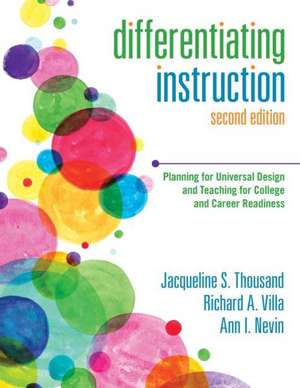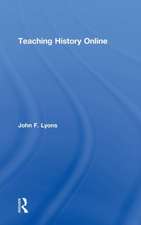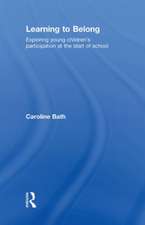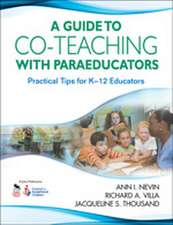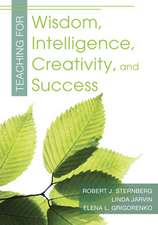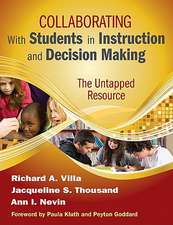Differentiating Instruction: Planning for Universal Design and Teaching for College and Career Readiness
Editat de Jacqueline S. Thousand, Richard A. Villa, Ann I. Nevinen Limba Engleză Paperback – 16 mar 2015
Preț: 312.97 lei
Nou
Puncte Express: 469
Preț estimativ în valută:
59.89€ • 62.17$ • 49.94£
59.89€ • 62.17$ • 49.94£
Carte disponibilă
Livrare economică 01-15 martie
Livrare express 15-21 februarie pentru 52.11 lei
Preluare comenzi: 021 569.72.76
Specificații
ISBN-13: 9781483344454
ISBN-10: 1483344452
Pagini: 360
Dimensiuni: 216 x 279 x 23 mm
Greutate: 0.84 kg
Ediția:Second Edition
Editura: SAGE Publications
Colecția Corwin
Locul publicării:Thousand Oaks, United States
ISBN-10: 1483344452
Pagini: 360
Dimensiuni: 216 x 279 x 23 mm
Greutate: 0.84 kg
Ediția:Second Edition
Editura: SAGE Publications
Colecția Corwin
Locul publicării:Thousand Oaks, United States
Recenzii
"Thousand, Villa, and Nevin take three very big ideas in education - Universal Design, Collaboration, and Differentiated Instruction - and combine them in a novel and engaging way. And they practice what they preach – the information and examples speak to someone just beginning to differentiate instruction as well as the expert who wants to further refine his or her craft."
"The extensive emphasis on technology throughout the book and in the case studies and lesson plans provides a rich resource to the readers of this exciting text. Administrators, university instructors, and staff developers will find this a valuable tool to support their students and colleagues on their differentiation journey. "
"This book provides a whole range of practical tools for meeting wide-ranging student needs. Can’t start from scratch because of district mandates and pre-purchased curricula? Fine—here’s how to retrofit to accommodate student needs. Want to develop an instructional plan based on UDL principles? Fine—here it is, from soup to nuts. Teachers, university students, and administrators will find practical solutions to instruction firmly embedded in evidence-based theory, to meet all of their needs."
"The extensive emphasis on technology throughout the book and in the case studies and lesson plans provides a rich resource to the readers of this exciting text. Administrators, university instructors, and staff developers will find this a valuable tool to support their students and colleagues on their differentiation journey. "
"This book provides a whole range of practical tools for meeting wide-ranging student needs. Can’t start from scratch because of district mandates and pre-purchased curricula? Fine—here’s how to retrofit to accommodate student needs. Want to develop an instructional plan based on UDL principles? Fine—here it is, from soup to nuts. Teachers, university students, and administrators will find practical solutions to instruction firmly embedded in evidence-based theory, to meet all of their needs."
Cuprins
A Letter to Our Readers
Acknowledgments
About the Authors
1. Why Differentiation of Instruction Now?
What Differentiated Instruction IS (and What It Is NOT)
Rationales for Differentiated Instruction
Rationale #1: To Meet Needs of Diverse Learners
Rationale #2: To Meet Legal Mandates
Rationale #3: To Be Ethical in Implementing Democratic Values
Rationale #4: To Dispel Myths About Students
Rationale #5: To Be Effective Teachers
Retrofit and Universal Design: Two Approaches to Differentiated Instruction
Systemic Support for Differentiated Instruction
Overview of the Book
2. Accessing the General Education Curriculum Through a Retrofit Framework
What Is the Retrofit Approach?
Scenario #1: Elementary Science and Social Studies
Scenario #2: Middle Level Mathematics
Scenario #3: Middle Level Science
Scenario #4: High School Language Arts
What Do You Know About Retrofitting as a Way to Differentiate Instruction?
3. Access to Curriculum Through Universal Design for Learning
The UDL Cycle for Differentiating Content, Product, and Process
Design Point #1: Gathering Facts About the Learners
Design Point #2: Differentiate Content and Materials
Design Point #3: Product or Differentiate How Students Show What They Know
Design Point #4: Differentiate Instructional Processes
Pause and Reflect About Student-Specific Teaching Strategies and Supports
Putting It All Together With the Universal Design Lesson Plan
4. Gathering Facts About the Learners
Record Review
Family-Centered and Culturally Responsive Fact Gathering
Interest Inventories
Learning Preferences Information
Learning and Thinking Styles
Multiple Intelligences
Data-Based Observations Including Functional Behavioral Assessments and Cooperative Group Monitoring
Data-Based Observations
Functional Behavioral Assessment
Monitoring Cooperative Group Learning
Curriculum-Based Assessments
Making Action Plans (MAPs)
Disability-Specific Information
Co-Teacher Roles in Gathering Facts About the Learners
Pause and Reflect
5. Differentiating Access to the Content of Learning
What Is Content?
Ways to Promote Access to Content
Taxonomies and Objectives: Using and Not Abusing Them
Layered Curriculum and Levels of Participation
Differentiating Content Using Graphic Organizers and Educational Technology
Differentiating Content With Culturally and Linguistically Responsive Techniques
Involving Students in Determining Content
Co-Teacher Roles in Differentiating Content
Pause and Reflect
6. Differentiating and Assessing the Products of Learning
Why Differentiate Assessment in a Climate of High-Stakes Testing?
Using Culturally Responsive Techniques to Differentiate and Assess the Products of Learning
Taxonomy and Learning Preferences Frameworks to Differentiate Products and Assessment
Using Bloom’s Taxonomy to Differentiate Products and Assessment
Using Learning Preferences Frameworks to Differentiate Products and Assessment
Using Bloom’s Taxonomy and Multiple Intelligences Theory to Differentiate Products and Assessment
Scaffolding and Curriculum-Based Assessments
Scaffolding as Formative Assessment
Curriculum-Based Assessment
Differentiating How Teachers Grade Products
Alternatives to Norm-Referenced Grading Procedures
Adapting Criterion-Referenced Grading Systems
Self-Referenced Systems
Co-Teacher Roles in Differentiating Products of Learning
Pause and Reflect
7. Differentiating the Instructional Processes
The Complexities of the Process of Instruction (Graphic Organizer)
Instructional Formats
Instructional Arrangements
Highlights on Cooperative Learning
A Focus on Cooperative Strategies for Emerging and Struggling Readers
A Highlight on Peer Tutors and Partner Learning Arrangements
Instructional Strategies
Using Taxonomies
Applying Concepts From Learning Preferences Frameworks
Integrating the Arts
Social and Physical Environment
Co-Teaching Approaches
Pause and Reflect
8. Collaborative Planning and Evaluation for Differentiated Instruction
The Rationale and Benefits of Collaborative Planning and Teaching
Effective and Efficient Use of Planning and Evaluation Time
Development of Relationships Among Team Members: It’s a Process!
Skills for Building Trust and Establishing Team Norms
Communication and Leadership Skills
Creative Problem-Solving Skills
Conflict Resolution Skills
Are We Really an Effective Planning Team?
9. Co-Teaching to Deliver Differentiated Instruction
Why Collaborate to Co-Teach?
Research Base for Co-Teaching
Who Can Be Co-Teachers?
Four Approaches to Co-Teaching
Supportive Co-Teaching
Parallel Co-Teaching
Complementary Co-Teaching
Team Co-Teaching
Questions About Co-Teaching to Differentiate Instruction
10. UDL Lesson Planning Cycle to Differentiate Instruction in Action: A Fourth-Grade Social Studies Unit
Setting the Context
Co-Teacher Professional Development Activities
Multiple Methods for Accessing Content
Differentiating the Products (Outcomes) of Learning
Differentiating the Instructional Processes
Instructional Format
Instructional Arrangements
Instructional Strategies
Social and Physical Environment
Co-Teaching Approaches
Implementing the UDL Plan
Using the Lesson Plan Template
11. UDL Lesson Planning Cycle to Differentiate Instruction in Action: Middle Level Mathematics
Who Are the Teachers?
Professional Development Activities
Gathering (New) Facts About the Learners
Multiple Methods for Accessing the Content for Algebra I
Differentiating the Products (Outcomes) of Learning
Differentiating the Instructional Processes
Group Investigation
Cognitively Guided Instruction
English Language Learner Techniques
Implementing the UDL Plan
Using the Universal Design Lesson Plan Template
12. UDL Lesson Planning Cycle to Differentiate Instruction in Action: Middle Level Science
Who Are the Teachers?
Planning to Change From a Retrofit Approach to a Universal Design Approach
Gathering (Additional) Facts About the Learners
Pause and Reflect: Tina
Planning Prior to the Lesson
Planning to Differentiate Content and Materials
Planning to Differentiate Products
Planning to Differentiate the Process of Learning
Finalizing the Lesson Plan
Differentiation in Action in the Class
Reflection
13.UDL Lesson Planning Cycle to Differentiate Instruction in Action: High School Language Arts
Who Are the Teachers?
Co-Teacher Professional Development Activities
Gathering Facts About the Learners
Differentiating the Content and Materials
Key Ideas and Details
Craft and Structure
Range of Reading and Level of Text Complexity
Differentiating the Product
Pause and Reflect
Differentiating the Process
Co-Teacher Roles
The Planned Lesson
Before the Lesson
The Planned Instructional Sequence
Pause and Reflect
14. UDL Lesson Planning Cycle to Differentiate Instruction in Action: High School Mathematics
Who Are the Teachers?
Co-Teacher Collaborative Planning and Professional Development Activities
Gathering Facts About the Learners
Anticipating Learners’ Interests, Learning Preferences, Skills, and Conceptual Understanding
Multiple Methods for Accessing the Content of Algebra II
Unit Theme: Reasoning and Sensemaking
Standards Addressed in the Unit
Differentiating the Product: Multiple Methods to Demonstrate Unit Objectives
Implementation
Assessment of Prior Knowledge/Mastery
Differentiating the Process of Instruction
Planning for Differentiation to Include Evidence-Based Strategies
Implementing Differentiated Instructional Processes
Using the Lesson Plan Template
Reflections
Reflections on Facts About the Learners
Reflections on Content and Materials Differentiation
Reflections on Product and Assessment Differentiation
Reflections on Instructional Process Differentiation
Peer Observer Feedback and Future Goals
15. Epilogue: Pause and Reflect
Values and Assumptions About Students
Values and Assumptions About Adults
Why Explain Values and Assumptions?
References
Resources
Index
Acknowledgments
About the Authors
1. Why Differentiation of Instruction Now?
What Differentiated Instruction IS (and What It Is NOT)
Rationales for Differentiated Instruction
Rationale #1: To Meet Needs of Diverse Learners
Rationale #2: To Meet Legal Mandates
Rationale #3: To Be Ethical in Implementing Democratic Values
Rationale #4: To Dispel Myths About Students
Rationale #5: To Be Effective Teachers
Retrofit and Universal Design: Two Approaches to Differentiated Instruction
Systemic Support for Differentiated Instruction
Overview of the Book
2. Accessing the General Education Curriculum Through a Retrofit Framework
What Is the Retrofit Approach?
Scenario #1: Elementary Science and Social Studies
Scenario #2: Middle Level Mathematics
Scenario #3: Middle Level Science
Scenario #4: High School Language Arts
What Do You Know About Retrofitting as a Way to Differentiate Instruction?
3. Access to Curriculum Through Universal Design for Learning
The UDL Cycle for Differentiating Content, Product, and Process
Design Point #1: Gathering Facts About the Learners
Design Point #2: Differentiate Content and Materials
Design Point #3: Product or Differentiate How Students Show What They Know
Design Point #4: Differentiate Instructional Processes
Pause and Reflect About Student-Specific Teaching Strategies and Supports
Putting It All Together With the Universal Design Lesson Plan
4. Gathering Facts About the Learners
Record Review
Family-Centered and Culturally Responsive Fact Gathering
Interest Inventories
Learning Preferences Information
Learning and Thinking Styles
Multiple Intelligences
Data-Based Observations Including Functional Behavioral Assessments and Cooperative Group Monitoring
Data-Based Observations
Functional Behavioral Assessment
Monitoring Cooperative Group Learning
Curriculum-Based Assessments
Making Action Plans (MAPs)
Disability-Specific Information
Co-Teacher Roles in Gathering Facts About the Learners
Pause and Reflect
5. Differentiating Access to the Content of Learning
What Is Content?
Ways to Promote Access to Content
Taxonomies and Objectives: Using and Not Abusing Them
Layered Curriculum and Levels of Participation
Differentiating Content Using Graphic Organizers and Educational Technology
Differentiating Content With Culturally and Linguistically Responsive Techniques
Involving Students in Determining Content
Co-Teacher Roles in Differentiating Content
Pause and Reflect
6. Differentiating and Assessing the Products of Learning
Why Differentiate Assessment in a Climate of High-Stakes Testing?
Using Culturally Responsive Techniques to Differentiate and Assess the Products of Learning
Taxonomy and Learning Preferences Frameworks to Differentiate Products and Assessment
Using Bloom’s Taxonomy to Differentiate Products and Assessment
Using Learning Preferences Frameworks to Differentiate Products and Assessment
Using Bloom’s Taxonomy and Multiple Intelligences Theory to Differentiate Products and Assessment
Scaffolding and Curriculum-Based Assessments
Scaffolding as Formative Assessment
Curriculum-Based Assessment
Differentiating How Teachers Grade Products
Alternatives to Norm-Referenced Grading Procedures
Adapting Criterion-Referenced Grading Systems
Self-Referenced Systems
Co-Teacher Roles in Differentiating Products of Learning
Pause and Reflect
7. Differentiating the Instructional Processes
The Complexities of the Process of Instruction (Graphic Organizer)
Instructional Formats
Instructional Arrangements
Highlights on Cooperative Learning
A Focus on Cooperative Strategies for Emerging and Struggling Readers
A Highlight on Peer Tutors and Partner Learning Arrangements
Instructional Strategies
Using Taxonomies
Applying Concepts From Learning Preferences Frameworks
Integrating the Arts
Social and Physical Environment
Co-Teaching Approaches
Pause and Reflect
8. Collaborative Planning and Evaluation for Differentiated Instruction
The Rationale and Benefits of Collaborative Planning and Teaching
Effective and Efficient Use of Planning and Evaluation Time
Development of Relationships Among Team Members: It’s a Process!
Skills for Building Trust and Establishing Team Norms
Communication and Leadership Skills
Creative Problem-Solving Skills
Conflict Resolution Skills
Are We Really an Effective Planning Team?
9. Co-Teaching to Deliver Differentiated Instruction
Why Collaborate to Co-Teach?
Research Base for Co-Teaching
Who Can Be Co-Teachers?
Four Approaches to Co-Teaching
Supportive Co-Teaching
Parallel Co-Teaching
Complementary Co-Teaching
Team Co-Teaching
Questions About Co-Teaching to Differentiate Instruction
10. UDL Lesson Planning Cycle to Differentiate Instruction in Action: A Fourth-Grade Social Studies Unit
Setting the Context
Co-Teacher Professional Development Activities
Multiple Methods for Accessing Content
Differentiating the Products (Outcomes) of Learning
Differentiating the Instructional Processes
Instructional Format
Instructional Arrangements
Instructional Strategies
Social and Physical Environment
Co-Teaching Approaches
Implementing the UDL Plan
Using the Lesson Plan Template
11. UDL Lesson Planning Cycle to Differentiate Instruction in Action: Middle Level Mathematics
Who Are the Teachers?
Professional Development Activities
Gathering (New) Facts About the Learners
Multiple Methods for Accessing the Content for Algebra I
Differentiating the Products (Outcomes) of Learning
Differentiating the Instructional Processes
Group Investigation
Cognitively Guided Instruction
English Language Learner Techniques
Implementing the UDL Plan
Using the Universal Design Lesson Plan Template
12. UDL Lesson Planning Cycle to Differentiate Instruction in Action: Middle Level Science
Who Are the Teachers?
Planning to Change From a Retrofit Approach to a Universal Design Approach
Gathering (Additional) Facts About the Learners
Pause and Reflect: Tina
Planning Prior to the Lesson
Planning to Differentiate Content and Materials
Planning to Differentiate Products
Planning to Differentiate the Process of Learning
Finalizing the Lesson Plan
Differentiation in Action in the Class
Reflection
13.UDL Lesson Planning Cycle to Differentiate Instruction in Action: High School Language Arts
Who Are the Teachers?
Co-Teacher Professional Development Activities
Gathering Facts About the Learners
Differentiating the Content and Materials
Key Ideas and Details
Craft and Structure
Range of Reading and Level of Text Complexity
Differentiating the Product
Pause and Reflect
Differentiating the Process
Co-Teacher Roles
The Planned Lesson
Before the Lesson
The Planned Instructional Sequence
Pause and Reflect
14. UDL Lesson Planning Cycle to Differentiate Instruction in Action: High School Mathematics
Who Are the Teachers?
Co-Teacher Collaborative Planning and Professional Development Activities
Gathering Facts About the Learners
Anticipating Learners’ Interests, Learning Preferences, Skills, and Conceptual Understanding
Multiple Methods for Accessing the Content of Algebra II
Unit Theme: Reasoning and Sensemaking
Standards Addressed in the Unit
Differentiating the Product: Multiple Methods to Demonstrate Unit Objectives
Implementation
Assessment of Prior Knowledge/Mastery
Differentiating the Process of Instruction
Planning for Differentiation to Include Evidence-Based Strategies
Implementing Differentiated Instructional Processes
Using the Lesson Plan Template
Reflections
Reflections on Facts About the Learners
Reflections on Content and Materials Differentiation
Reflections on Product and Assessment Differentiation
Reflections on Instructional Process Differentiation
Peer Observer Feedback and Future Goals
15. Epilogue: Pause and Reflect
Values and Assumptions About Students
Values and Assumptions About Adults
Why Explain Values and Assumptions?
References
Resources
Index
Descriere
The ultimate guide to leaving no child behind—newly updated!
Now in its second edition, this best-selling book is your one-stop resource for differentiated instruction. Whether you’re new to the concept or just looking to improve your approach, you’ll find tools to meet the needs of all your students. You’ll discover how Universal Design for Learning (UDL) and retrofitting can help you adapt general education curriculum to diverse learning styles. Features of the new edition include
Now in its second edition, this best-selling book is your one-stop resource for differentiated instruction. Whether you’re new to the concept or just looking to improve your approach, you’ll find tools to meet the needs of all your students. You’ll discover how Universal Design for Learning (UDL) and retrofitting can help you adapt general education curriculum to diverse learning styles. Features of the new edition include
- A chapter on collaborative planning and evaluation
- Updated lesson plans tied to the Common Core
- Greater emphasis on cultural proficiency, ELLs, and gifted students
- New technology references and resources
- A strengthened link to RTI
